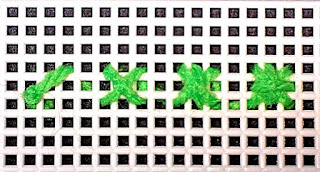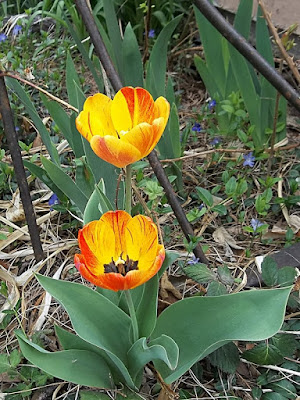 |
| Orange & yellow tulips in Annake's garden |
Not long ago, we had an interesting question on one of our Question and Answer posts. The question was, “Do four way designs have to be geometric?” (To date most of the four-way designs we have discussed have been for needlepoint, particularly bargello (
May 11, 2014, December 22, 2014, August 22, 2016). I replied that the short answer was, “Certainly not!” I went on to say the long answer would require one or more complete posts on the subject. This is the first of those posts. I thought back to a time some years ago when three classes of 5
th grade students had been studying about the tropics, particularly the state of Hawaii. I wanted them to do an art project related to the subject to complete the unit.
I have never asked my students to do a project — from kindergarten drawings to junior college term papers — that I did not do right along with them, so I did some research. I came across some materials about traditional Hawaiian quilts. These were done on square blocks in two colors, one for the cut-out silhouette and one for the background. The subjects were usually native plants as represented by flowers, fruit, and leaves. I did some practicing with colored construction paper.
 |
| Annake's pink orchid design on grey paper |
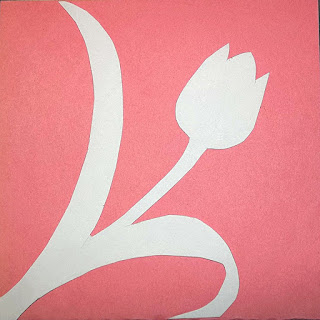 |
| Tulip design, cut from a quarter-folded sheet |
The next class day, I showed the classes how to cut a piece of rectangular paper to make it square. Then we folded each square into quarters. I drew a simple flower and leaf design on one of the small squares, beginning at the central corner. I cut out the design, unfolded the paper, and turned it over so that the drawing did not show. Pressing the paper flat on a square of a different color produced a design very similar to the Hawaiian quilt designs. I did a different design for each of the three classes and displayed them so they could be studied. Instead of the unfamiliar tropical flowers, I used familiar garden flowers from our town gardens, such as crocuses, tulips, daffodils and irises. I did, however, display photographs of tropical flowers to give them a choice.
 |
| Four-way tulip design, unfolded |
The assignment was to produce “quilt blocks” of their own. The first task was to produce a corner design that they thought was attractive. Since the drawings would not show on the finished cut-out, each student could do as many as four practice drawings. During the next session, each student chose the best drawing and cut it out of the folded paper (after being cautioned not to cut the four sections apart). Then each student chose a background square in a contrasting color and glued his or her pattern to it, carefully centering it on the background. They were allowed to add additional decoration if they desired.
Later all the projects were displayed on a wall of the school cafeteria. Most of the students then took their designs home, but a few wrote notes to me on the backs of their projects and gave them to me, a gesture that pleased me greatly. I want to show you three of these. (Yes, I kept them.) Remember that these were 10-year-old and 11-year-old children. The first one is typical of the designs. It combined a leaf cut-out with drawings of flowers and detailed drawing of the veins in the leaves. The second one is a very carefully and skillfully done cut-out with butterflies added in the corners, facing inward rather than outward. The last one is by a rule-breaker. (Those of you who have been reading these posts for the last four years know that I am a rule-breaker myself, and therefore probably more tolerant of rule-breaking than most people.) While the swans do hold together nicely, they are not connected at the center. It was then necessary for the young artist to place a patch of blue and white “waves” in the hole in the center of the design.
 |
| Student "quilt blocks" |
Now you may be asking yourself, “What does this have to do with me and my art or needlework?” That's a fair question. I expect, however, that the quilters among you have already started envisioning designs of your own. These might involve silhouettes of animals or toys for a baby's or child's quilt or vehicles or sports equipment for a man's pillow. The possibilities are endless. For those of you who want to further explore Hawaiian quilt designs, and who have a
Pinterest® account (
www.pinterest.com), there are enough ideas in their archives to keep you busy for years!
But let's return to the simple tulip design. You may wonder why I didn't make all the tulip leaves form “hearts”. That is easy enough to do. Try it for yourself. The answer is that I wanted a design that could be manipulated to fit a rectangle as well as a square. Since I had the pattern made, I cut it out of a couple of papers with patterned designs. Then I tried them in various combinations: plain-on-plain, plain-on-patterned, patterned-on-plain, patterned-on-patterned. Some of the most unlikely color and pattern combinations worked rather well, as you can see below.
 |
| Four-way square paterns with different paper combinations |
Tip: If you are a beginning quilter, you may find it useful to collect a variety of papers in various colors and patterns. Paint and wallpaper stores and decorator's shops often discard wallpaper pattern books. If you ask them to save those for you, many will do so, especially if you are doing projects with school children, Scouts, senior citizens, etc. It doesn't hurt to ask. Then you can take a pleasing paper pattern with you to a fabric store and look for fabrics in the colors and with similar scale patterns to your paper sample.
On our next post on the subject of four-way designs (later this year), we will discuss multi-colored four-way designs in painting, collage, crewel, tent stitch, reverse applique, etc. In the meantime...
Use your imaginations,

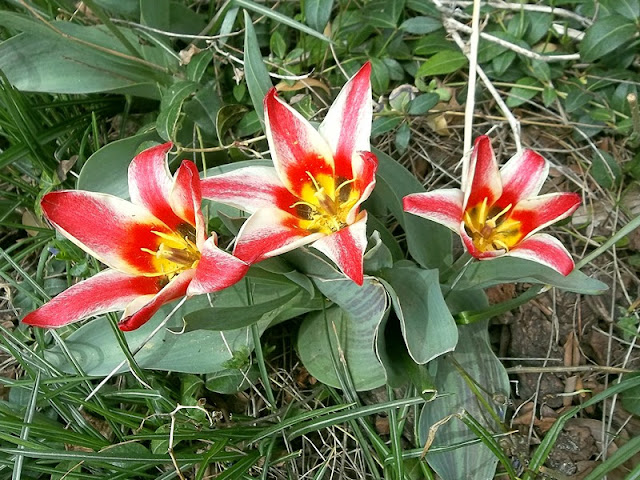 |
| More tulips from Annake's Garden |
 This post by Annake's Garden is licensed under a Creative Commons Attribution-NonCommercial-ShareAlike 3.0 Unported License.
This post by Annake's Garden is licensed under a Creative Commons Attribution-NonCommercial-ShareAlike 3.0 Unported License.
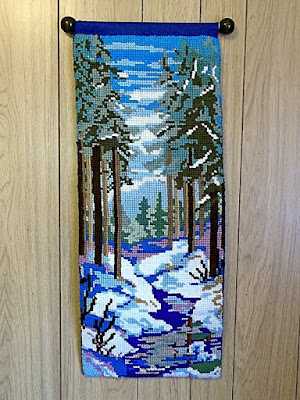


 This post by Annake's Garden is licensed under a Creative Commons Attribution-NonCommercial-ShareAlike 3.0 Unported License.
This post by Annake's Garden is licensed under a Creative Commons Attribution-NonCommercial-ShareAlike 3.0 Unported License.
